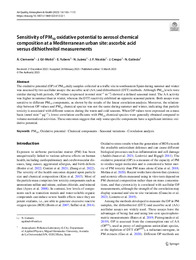Por favor, use este identificador para citar o enlazar este ítem:
https://hdl.handle.net/11000/30149Registro completo de metadatos
| Campo DC | Valor | Lengua/Idioma |
|---|---|---|
| dc.contributor.author | Clemente, Á. | - |
| dc.contributor.author | Gil Moltó, Juan | - |
| dc.contributor.author | Yubero Funes, Eduardo | - |
| dc.contributor.author | Juárez, N. | - |
| dc.contributor.author | Nicolás, J.F. | - |
| dc.contributor.author | Crespo, J. | - |
| dc.contributor.author | Galindo, Nuria | - |
| dc.contributor.other | Departamentos de la UMH::Física Aplicada | es_ES |
| dc.date.accessioned | 2023-11-14T08:19:52Z | - |
| dc.date.available | 2023-11-14T08:19:52Z | - |
| dc.date.created | 2023-03-01 | - |
| dc.identifier.citation | Air Quality, Atmosphere & Health (2023) | es_ES |
| dc.identifier.issn | 1873-9326 | - |
| dc.identifier.issn | 1873-9318 | - |
| dc.identifier.uri | https://hdl.handle.net/11000/30149 | - |
| dc.description.abstract | The oxidative potential (OP) of PM10 daily samples collected at a traffic site in southeastern Spain during summer and winter was assessed by two acellular assays: the ascorbic acid (AA) and dithiothreitol (DTT) methods. Although PM10 levels were similar during both periods, OP values (expressed in nmol min− 1 m− 3) showed a defined seasonal trend. The AA activity was higher in summer than in winter, whereas the DTT reactivity exhibited an opposite seasonal pattern. Both assays were sensitive to different PM10 components, as shown by the results of the linear correlation analysis. Moreover, the relationship between OP values and PM10 chemical species was not the same during summer and winter, indicating that particle toxicity is associated with different sources during the warm and cold seasons. When OP values were expressed on a mass basis (nmol min− 1 μg−1), lower correlation coefficients with PM10 chemical species were generally obtained compared to volume-normalized activities. These outcomes suggest that only some specific components have a significant intrinsic oxidative potential. | es_ES |
| dc.format | application/pdf | es_ES |
| dc.format.extent | 8 | es_ES |
| dc.language.iso | eng | es_ES |
| dc.rights | info:eu-repo/semantics/openAccess | es_ES |
| dc.rights.uri | http://creativecommons.org/licenses/by-nc-nd/4.0/ | * |
| dc.subject | Oxidative potential | es_ES |
| dc.subject | Chemical components | es_ES |
| dc.subject | Seasonal variations | es_ES |
| dc.subject | Correlation analysis | es_ES |
| dc.subject.other | CDU::5 - Ciencias puras y naturales::53 - Física | es_ES |
| dc.title | Sensitivity of PM10 oxidative potential to aerosol chemical composition at a Mediterranean urban site: ascorbic acid versus dithiothreitol measurements | es_ES |
| dc.type | info:eu-repo/semantics/article | es_ES |
| dc.relation.publisherversion | https://doi.org/10.1007/s11869-023-01332-1 | es_ES |

Ver/Abrir:
Clemente et al 2023_AQAH.pdf
655,05 kB
Adobe PDF
Compartir:
 La licencia se describe como: Atribución-NonComercial-NoDerivada 4.0 Internacional.
La licencia se describe como: Atribución-NonComercial-NoDerivada 4.0 Internacional.
.png)